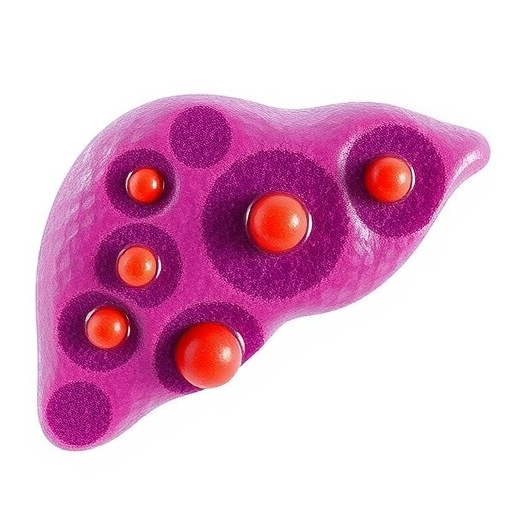Recent advancements in medical research have illuminated the complex interplay between the immune system and liver disease, particularly through studying neutrophils and their role in liver fibrosis. A new study by Li, Y., Lu, Y., and Huang, B., published in the Journal of Translational Medicine, examines biomarkers associated with neutrophil extracellular traps (NETs) in the context of liver fibrosis. This study combines machine learning methodologies with experimental validation, representing a significant leap in understanding and diagnosing this critical condition affecting millions worldwide.
Liver fibrosis is characterized by excessive accumulation of extracellular matrix proteins, leading to liver scarring and progressive liver dysfunction. It is a common consequence of various liver diseases, including chronic viral hepatitis, alcoholic liver disease, and non-alcoholic fatty liver disease. Early diagnosis and staging of liver fibrosis are essential, as they greatly influence treatment decisions and prognosis. Unfortunately, traditional liver biopsy methods are invasive and carry risks, highlighting the need for non-invasive diagnostic methods.
The role of neutrophils in liver disease has been an area of growing interest among researchers. These white blood cells are not only the body’s first line of defense against infections but also participate in various inflammatory processes. Their ability to form NETs—fibrous structures that trap pathogens—has been implicated in tissue repair and regeneration, but a deeper understanding of their role in fibrosis remains elusive. The current study aims to fill this knowledge gap and explore how NET-associated biomarkers could serve as prognostic indicators in liver fibrosis.
Utilizing machine learning algorithms, the researchers analyzed a comprehensive dataset that included clinical samples of liver fibrosis patients. The integration of advanced computational techniques allowed the researchers to identify patterns and correlations within the data that were not previously apparent. Through rigorous training processes, the model became adept at distinguishing between different stages of fibrosis based on the presence of specific NET biomarkers.
This pioneering use of machine learning not only enhances the accuracy of fibrosis staging but also brings forth the potential for personalized medicine. By correlating NET biomarkers with clinical outcomes, the study suggests that these markers could provide valuable insights into the severity of liver damage and the patient’s overall prognosis. This approach could significantly reduce the need for invasive procedures, leading to improved patient comfort and outcomes.
In tandem with machine learning, the research also involved experimental validation. By employing both in vitro and in vivo models, the researchers demonstrated that elevated levels of specific NET biomarkers were associated with increased fibrosis severity. This experimental aspect provided concrete evidence supporting the computational findings, thereby reinforcing the potential clinical applicability of the identified biomarkers.
The research findings are particularly timely, considering the increasing global prevalence of liver diseases. According to the World Health Organization, liver disease is a leading cause of morbidity and mortality worldwide, with fibrosis serving as a key transitional stage to more severe conditions, including cirrhosis and hepatocellular carcinoma. Early detection and intervention are critical to altering disease progression, making the discovery of non-invasive biomarkers even more crucial.
As the scientific community continues to unravel the complexities of liver fibrosis, the integration of novel diagnostic techniques such as those proposed in this study represents a paradigm shift. The traditional reliance on liver biopsies may soon transition toward more accessible blood tests that can provide real-time information about a patient’s liver health. With ongoing research and validation, NET-associated biomarkers have the potential to become standard components of clinical diagnostics in hepatology.
Moreover, the implications extend beyond liver disease. The role of neutrophils and NETs in various other diseases—such as autoimmune conditions, cardiovascular diseases, and infections—suggests that the findings from this study could have far-reaching consequences in multiple fields of medicine. By establishing a clearer understanding of the mechanisms behind NET formation and its implications, future therapeutic strategies could be developed to mitigate not only fibrosis but other related pathological conditions as well.
The collaborative nature of this research underscores the importance of interdisciplinary efforts in modern medicine. Combining insights from immunology, machine learning, and clinical practice creates a robust framework for tackling complex health issues. This study exemplifies how diverse scientific disciplines can converge to foster simpler, more effective patient care solutions.
Furthermore, the publication in a reputable journal such as the Journal of Translational Medicine ensures that these groundbreaking findings will reach a wide audience, fostering further exploration and validation across institutions. Knowledge dissemination is crucial for stimulating further research, attracting funding, and paving the way for clinical trials aimed at assessing the feasibility of these biomarkers in routine practice.
In conclusion, the study led by Li, Y., Lu, Y., and Huang, B. marks a significant step forward in the quest to improve liver fibrosis diagnostics and treatment. The innovative use of machine learning combined with rigorous experimental validation presents a compelling case for the adoption of NET-associated biomarkers in clinical settings. By reducing reliance on invasive procedures and enhancing diagnostic accuracy, this research holds promise for transforming how liver diseases are managed, thereby improving outcomes for patients around the globe.
As the landscape of liver disease management evolves, continued investigation into the role of the immune system will likely reveal additional therapeutic targets and diagnostic indicators. The future of hepatology is poised to incorporate these advancements, ultimately leading to a more nuanced approach to patient care that prioritizes early detection, personalized treatment, and improved quality of life.
Subject of Research: Neutrophil extracellular trapping network-associated biomarkers in liver fibrosis.
Article Title: Neutrophil extracellular trapping network-associated biomarkers in liver fibrosis: machine learning and experimental validation.
Article References:
Li, Y., Lu, Y., Huang, B. et al. Neutrophil extracellular trapping network-associated biomarkers in liver fibrosis: machine learning and experimental validation.
J Transl Med 23, 1058 (2025). https://doi.org/10.1186/s12967-025-06819-2
Image Credits: AI Generated
DOI: 10.1186/s12967-025-06819-2
Keywords: Neutrophils, Liver Fibrosis, Biomarkers, Machine Learning, Extracellular Traps, Liver Disease, Immunology, Experimental Validation.




